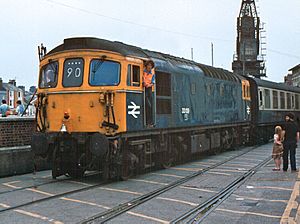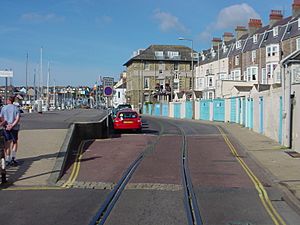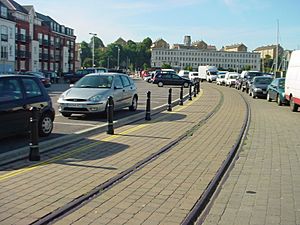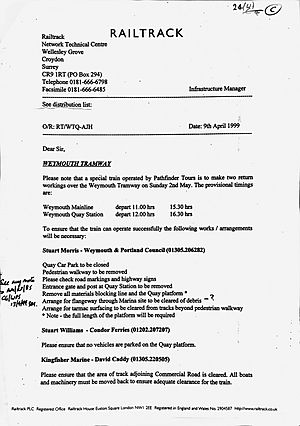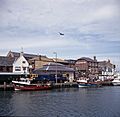Weymouth Harbour Tramway facts for kids
The Weymouth Harbour Tramway was a special railway line. It ran right on the streets of Weymouth, Dorset, England. This line connected Weymouth's main train station to Weymouth Harbour. It was built in 1865. Regular trains stopped using it in 1987. The very last train ran in 1999. The tracks were removed between 2020 and 2021.
Contents
A Look Back: The Tramway's History
The Weymouth Harbour Tramway first opened in 1865. It was built by the Great Western Railway company. The tracks ran from the main train station, along the streets, and right to the harbour.
Early Days and Passenger Travel
At first, the tramway mainly carried goods. But in 1889, passenger trains started using it. These trains took people directly to the Channel Island ferries. This made it easy for travellers to connect from the train to the boat.
Changes and Upgrades Over Time
As more goods were transported, the line grew. Extra tracks, called sidings, were added. These helped trains load and unload goods at different businesses along the harbour.
In 1930, the Town Bridge was rebuilt. The tramway tracks were moved to a new spot on the bridge. Then, between 1938 and 1939, a tight curve in the track was straightened out. This made the line smoother and safer.
End of Regular Services
Over the years, the Quay station grew. It started with one track and became a three-track area by 1961. Regular goods trains stopped running in 1972. However, fuel oil was still carried to the pier until 1983.
Regular passenger services ended in 1987. This happened because the main railway line into Weymouth got new electric power. This power system, called third rail electrification, was not safe for trains running on public streets.
There was a short test in 1997 with a special vehicle. It used a flywheel to move. But this did not lead to the tramway being used regularly again. The very last train on the line was a special trip in May 1999.
How Trains Operated on the Streets
Running trains on public streets was unique. Special rules were needed to keep everyone safe.
Warning Equipment for Public Safety
Trains on the tramway had special warning equipment. This included a yellow box with a spinning amber light and a bell. This equipment was plugged into the train. The train driver could control the bell to warn people.
Guiding Trains Through Town
When a train was ready to go to the quay, it would stop. Railway staff would attach the warning equipment. Then, railway workers with flags would "walk" in front of the train. They would clear the path of people and badly parked cars. This made sure the train could move safely through the streets. Once the train reached the quay, the staff would move the warning equipment to the other end for the return trip. Sometimes, the British Transport Police also helped guide the trains.
The Tramway in the 21st Century
In 2009, the local council wanted to remove the tramway. Network Rail, who owned the line, agreed they no longer needed it. The council even planned to buy the line.
Efforts to Save the Line
However, the sale never happened. In 2014, a group started a campaign to reopen the tramway. They believed it would help tourism and reduce car use in Weymouth. A petition was even started online in 2015. In 2016, the council tried to officially close the line forever, but Network Rail did not make that change.
Final Removal of Tracks
In 2019, a group called the Campaign for Better Transport listed the line as a priority for reopening. But in February 2020, money was given to remove the tracks. Work to take up the tracks began on October 5, 2020.
Images for kids
-
Passenger train weaving between fishing boats and buildings in 1994, with Concorde overhead


